From 2000 to 2005 the world lost over a million square kilometers of forest.
Forests continue to decline worldwide, according to a new study in the Proceedings of the National Academy of Science (PNAS). Employing satellite imagery researchers found that over a million square kilometers of forest were lost around the world between 2000 and 2005. This represents a 3.1 percent loss of total forest as estimated from 2000. While the study did not look at forest gains during the same time period, it reveals some surprises about where and how much forest was lost: including the fact that from 2000 to 2005 both the United States and Canada had higher percentages of forest loss than even Brazil.
Counting forest loss due either to human disturbance or natural causes, the study found that North America lost the most forest of the world’s six forest-containing continents. Perhaps surprisingly, thirty percent of total forest loss occurred in North America alone. Combined with South America—the largest extent of tropical forests in the world—the two continents represent half of the world’s total forest loss. Africa, in turn, suffered the least forest loss.
Forest loss by nation
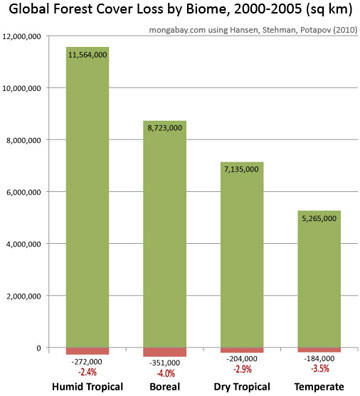 Global forest cover loss by biome, 2000-2005. Chart by Rhett A. Butler / mongabay.com. Click to enlarge. |
Of the seven nations that contain over a million square kilometers of forest—Russia, Brazil, the United States, Canada, Indonesia, China, and the Democratic Republic of Congo—Brazil lost the most total forest during the five year time period.
According to the researchers Brazil lost 26,000 square kilometers (10,038 square miles) per year of its rainforest, and 7,000 square kilometers (2,702 square miles) in its dry tropical forests. Over the five years, total forest loss in Brazil came to 165,000 square kilometers (63,706 square miles). In all this represents 3.6 percent of its total 2000 forest cover: half a percent higher than the global average. However, the study does not incorporate small-scale logging or forest degradation in places like Brazil unless the canopy cover falls below 25 percent.
Canada was close behind Brazil: losing some 160,000 square kilometers (61,776 square miles) of its forest cover. However, proportionally Canada’s forest loss equals 5.2 percent of the nation’s total forest cover: higher than Brazil’s percentage and over two points higher than the global average.
But the United States had the greatest percentage loss of the seven nations—even more than Brazil and Canada—losing 6 percent of its forest cover in just five years time, a total of 120,000 square kilometers (46,332 square miles). While fire and beetle infestation played a role in Alaska and the western US, large-scale logging industries in the southeast, along the western coast, and in the Midwest play a big role in the nation’s forest loss.
“This does not mean that [the forests] do not regenerate, and we make no statements whatsoever about sustainability,” lead author Matthew Hansen explained to USA Today. “But, compared to other regions of the world, a lot is going on.”
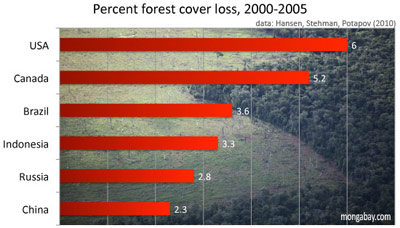 Percent forest cover loss by for major forest countries, 2000-2005. Chart by Rhett A. Butler / mongabay.com. Click to enlarge. |
The researchers write that “the often publicized phenomenon of forest conversion within the humid tropics is observed in our results, but significant GFCL [i.e. global forest cover loss] is evident in all biomes. For example, rates of GFCL in regions such as the southeast United States are among the highest globally.”
Of the other seven nations: Indonesia lost 3.6 percent of its forest cover during the five years, Russia 2.8 percent, China 2.3 percent, while the Democratic Republic of Congo lost the smallest percentage: 0.6 percent.
The study also highlights other countries with significant forest loss including Malaysia due to palm oil plantations, Paraguay and Argentina to agriculture, and Australia to fires.
Forest loss by ecosystem
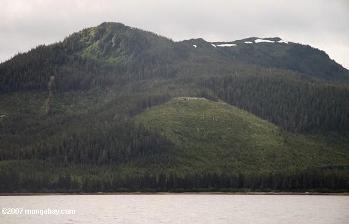 Clear-cut logging in Alaska. Photo by: Rhett A. Butler. |
Comparing the world’s four major forest ecosystems, the study found that the boreal experienced the largest loss in the five years, tropical rainforests came in second, dry tropical forest were third, and finally temperate forests
In the boreal 60 percent of the loss was due to fires, while the remaining 40 percent was caused by logging, disease, and infestations of pine beetles linked to climate change.
For tropical rainforests the majority of the loss was due to clearing for agriculture in Brazil and plantations in Indonesia and Malaysia. The report found that while the Congo Basin was impacted by some logging, large-scale clearing for agriculture was not yet an issue leaving the region with less forest decline.
Dry tropical forests were largely impacted by clearing for agriculture in places like Brazil, Paraguay, and Argentina.
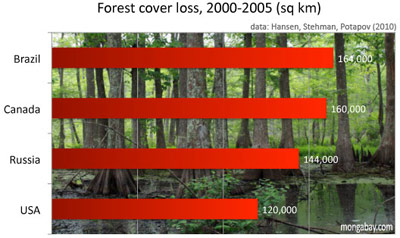 Total forest loss (natural and deforestation) for the United States, China, Brazil, and Russia, 2000-2005. Chart by Rhett A. Butler / mongabay.com. Click to enlarge. |
Temperate forests suffered the least amount of total loss because, as the researchers write, “the majority of this biome has long been converted to agricultural and settlement land uses.” Yet proportionally, temperate forests came in second of the four forest types largely due to high forest loss in the United States.
In measuring forest loss, the study calculated forest cover as 25 percent of canopy cover with trees over 5 meters high.
CITATION: Hansen, Matthew C.; Stehman, Stephen V.; and Potapov, Peter V. Quantification of global gross forest cover loss. PNAS. www.pnas.org/cgi/doi/10.1073/pnas.0912668107.
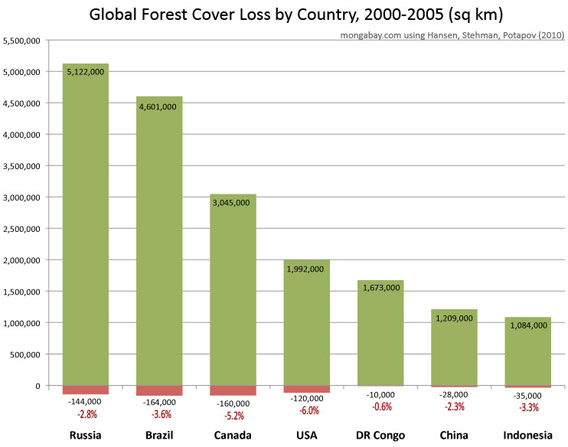
Global forest cover loss by country, 2000-2005. Chart by Rhett A. Butler / mongabay.com. Click to enlarge.
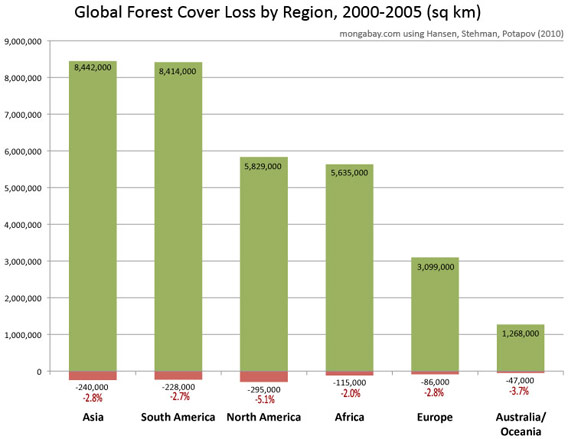
Global forest cover loss by country, 2000-2005. Chart by Rhett A. Butler / mongabay.com. Click to enlarge.
Related articles
Is deforestation rising or falling in the Amazon?
(04/18/2010) Last week Brazil’s National Space Agency INPE reported a 51 percent drop in Amazon deforestation in the six months ended February 2010 compared with the year earlier period. But the seemingly happy news for environmentalists may be premature.
US Eastern forests suffer “substantial” decline: 3.7 million hectares gone
(04/07/2010) The United States’ Eastern forests have suffered a “substantial and sustained net loss” over the past few decades, according to a detailed study appearing in BioScience. From 1973 to 2000, Eastern have declined by 4.1 percent or 3.7 million hectares. Deforestation occurred in all Eastern regions, but the loss was most concentrated in the southeastern plains.

(03/25/2010) Global forest loss has diminished since the 1990s but still remains “alarmingly high”, according to a preliminary version of a new assessment from the U.N. Food and Agriculture Organization (FAO). The report, Global Forest Resources Assessment 2010 (FRA 2010), shows that global forest loss slowed to around 13 million hectares per year during the 2000s, down from about 16 million hectares per year in the 1990s. It finds that net deforestation declined from about 8.3 million hectares per year in the 1990s to about 5.2 million hectares per year in the 2000s, a result of large-scale reforestation and afforestation projects, as well as natural forest recovery in some countries and slowing deforestation in the Amazon.
U.S. and Brazil sign deforestation agreement
(03/07/2010) Brazil and the United States have signed an agreement to worth together to reduce deforestation as part of an effort to slow climate change.
Australia pledges $30m to reduce deforestation in Sumatra
(03/03/2010) Australia will contribute A$30 million to a project to reduce deforestation in the province of Jambi, on the Indonesian island of Sumatra, reports Reuters.
Little more than 10,000 hectares of rainforest remains on Java
(01/24/2010) From 2003-2006, Java lost approximately 2,5000 hectares a year (10,000 hectares of forest in total) according to the Forestry Ministry. Despite the rate of loss being far lower in Java than other Indonesian islands (such as Borneo, Sumatra, and Sulawesi), Java is particularly threatened because there is so little forest left. If the past rate of deforestation occurs from 2007-2010 then by the end of the year conservation organization Pro Fauna predicts only 10,000 hectares of rainforest will remain on the island, leaving a number of unique and endangered species in deep trouble.
Brazil: king of conservation, deforestation for the 2000s

(12/21/2009) Brazil set aside more land in protected areas than any other country during the 2000s, accounting for nearly 60 percent of total terrestrial conservation during the decade, according to mongabay.com’s analysis of data from the U.N Environment Program and the World Conservation Monitoring Center. Paradoxically, Brazil also lost the most forest of any country during the decade.
Rich logging countries open logging loophole in plan to reduce deforestation
(12/15/2009) While one tropical forest policy group saw hopeful signs emerging in the most recent revision of the negotiating text on the reducing emissions from deforestation and degradation (REDD) mechanism at climate talks in Copenhagen, activist groups are warning that there remains a substantial logging loophole for developed countries.
Google Earth to monitor deforestation

(12/10/2009) It what could be a critical development in helping tropical countries monitor deforestation, Google has unveiled a partnership with scientists using advanced remote sensing technology to rapidly analyze and map forest cover in extremely high resolution. The effort could help countries detect deforestation shortly after it occurs making it easier to prevent further forest clearing.
Developed countries plan to hide emissions from logging

(12/09/2009) While developing countries in the tropics have received a lot of attention for their deforestation emissions (one thinks of Brazil, Indonesia, and Malaysia), emissions from logging—considered forest cover change—in wealthy northern countries has been largely overlooked by the media. It seems industrialized countries prefer it this way: a new study reveals just how these countries are planning to hide forestry-related emissions, allowing nations such as Canada, Russia, and the EU to contribute to climate change without penalty.
Changing drivers of deforestation provide new opportunities for conservation

(12/09/2009) Tropical deforestation claimed roughly 13 million hectares of forest per year during the first half of this decade, about the same rate of loss as the 1990s. But while the overall numbers have remained relatively constant, they mask a transition of great significance: a shift from poverty-driven to industry-driven deforestation and geographic consolidation of where deforestation occurs. These changes have important implications for efforts to protect the world’s remaining tropical forests in that environmental lobby groups now have identifiable targets that may be more responsive to pressure on environmental concerns than tens of millions of impoverished rural farmers. In other words, activists have more leverage than ever to impact corporate behavior as it relates to deforestation.
Destruction of old-growth forests looms over climate talks

(12/08/2009) Destruction of old-growth or primary forests looms large in discussions in Copenhagen over a scheme to compensate tropical countries for reducing emissions from deforestation and degradation (REDD). Some environmental groups are pressing for conservation of old-growth forests — the most carbon-dense, and biologically-rich state of forests — to be the centerpiece of REDD, while industry and other actors are pushing for “sustainable forest management” or logging using reduced-impact techniques to be the primary focus of REDD.